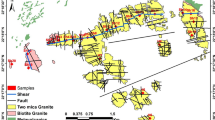Abstract
The natural stones are commonly used as interior and exterior building material. The accessory minerals of some rocks can generate a high amount of radon in the atmosphere. Ophiolitic rocks including serpentinites, metagabbros, gabbros metabasalts, metabasaltic-andesites, meta-andesites, Dokhan andesites, dacites, rhyolites, quartz diorites, tonalites, granodiorites, monzogranites and syenogranites. From the Eastern Desert of Egypt were analyzed for radon. The annual effective dose values of all studied rocks are higher than the world average due to the high radon content in the samples. The studied rocks are not recommended to be used as construction material.





Similar content being viewed by others
References
Cherniak DJ (2010) Diffusion in Accessory minerals: Zircon, Titanite, Apatite, Monazite and Xenotime. Rev Mineral Geochem 72(1):827–869
United Nations Scientific Committee on the Effects of Atomic Radiation (UNSCEAR) (1988) Sources, Effects and Risks of Ionizing Radiation. Report to the General Assembly, with annexes
United Nations Scientific Committee on the Effects of Atomic Radiation (UNSCEAR) (1993) Sources and Effects of Ionizing Radiation. Report to the General Assembly, with Scientific Annexes.
International Commission on Radiological Protection (ICRP) (2011) Radiological protection against radon exposure. Annals of the ICRP 4829–9671–6554
International Agency for Research on Cancer (IARC) (1988) Summaries & Evaluations, vol 43. WHO, Radon, p 1988
Ishimori Y, Lange K, Martin P, Mayya Y, Phaneuf M (2013) Measurement and calculation of radon releases from NORM residues. Technical reports series no. 474. International atomic energy agency Vienna.
Hosoda M, Sorimachi A, Yasuoka Y, Ishikawa T, Sahoo SK, Furukawa M, Uchida S (2009) Simultaneous measurements of radon and thoron exhalation rates and comparison with values calculated by UNSCEAR equation. J Radiat Res 50(4):333–343
Moed BA, Nazaroff WW, Sextro RG (1988) Soil as a source of indoor radon: generation, migration and entry, radon and its decay products in indoor air (naZaroff, w.w., nero Jr., a.V., eds). Wiley, New York
Schery S, Whittlestone S, Hart K, Hill S (1989) The flux of radon and thoron from Australian soils. J Geophys Res Atmos 94(D6):8567–8576
Abd El Fattah MMG (2007) Geology and petrology and radioactivity of Wadi El Ghozah-Wadi Abu El Hassan Al Aswad area, North Eastern Desert, Egypt. P.hD. Thesis, Fac. Sci., Benha Univ., Benha, Egypt, 300p.
AlphaGUARD (2012) Alpha GUARD portable radon monitor. Saphymo GmbH, Frankfurt
Salaheldin G, Tolba A, Kamel M, El-Taher A (2020) Radiological hazard parameters of natural radionuclides for neoproterozoic rocks from Wadi Um Huytat in central eastern desert of Egypt. J Radioanal Nucl Chem 325:397–408
Hassan NM (2014) Radon emanation coefficient and its exhalation rate of wasted petroleum samples associated with petroleum industry in Egypt. J Radioanal Nucl Chem 299(1):111–117
Harb S, Ahmed N, Elnobi S (2016) Effect of grain size on the radon exhalation rate and emanation coefficient of soil, phosphate and building material samples. J Nucl Part Phys 6:80–87
International Commission on Radiological Protection (ICRP) (1993) ICRP 65: Protection against Radon-222 at home and at work, vol 23. Pergamon Press, Oxford
United Nations Scientifc Committee on the Efects of Atomic Radiation (UNSCEAR) (2000) Sources and efects of ionizing radiation. United Nations, New York, pp 453–487
Hassan NM, Ishikawa T, Hosoda M, Iwaoka K, Sorimachi A, Sahoo SK, Janik M, Kranrod C, Yonehara H, Fukushi M, Tokonami S (2011) The effect of water content on the radon emanation coefficient for some building materials used in Japan. Radiat Meas 46(2):232–237
Gupta M, Mahur AK, Verma KD (2011) Monitoring of indoor radon and its progeny in dwellings of Delhi using SSNTDs. Adv Appl Sci Res 2:421–426
El-Taher A, Kamel M, Tolba A, Salaheldin G (2020) Radiation detection technology and methods evaluation of natural radioactivity and radiological hazards in basement rocks from gabel Abu El-Hassan in the North Eastern Desert of Egypt by multivariate statistical approach with remote sensing data. Radiat Detect Technol & Meth. https://doi.org/10.1007/s41605-020-00213-w
Guo Q, Cheng J (2005) Indoor thoron and radon concentrations in Zhuhai. China J Nucl Sci Technol 42(6):588–591
El-Taher A (2012) Measurement of radon concentrations and their annual efective dose exposure in groundwater from Qassim area. Saudi Arabia J Environ Sci Technol 5(6):475–481
Kodolanyi J, Pettke T, Spandler C, Kamber BS, Gmeling K (2012) Geochemistry of ocean floor and fore-arc serpentinites: constraints on the ultramafic input to subduction zones. J Petrol 53(2):235–270
Acknowledgements
The author is very thankful to prof. Dr. Mervat El-Haddad from the Geology Department, Assiut University for her collaboration, positive discussions.
Author information
Authors and Affiliations
Corresponding author
Ethics declarations
Conflict of interest
No potential conflict of interest was reported by the author.
Additional information
Publisher's Note
Springer Nature remains neutral with regard to jurisdictional claims in published maps and institutional affiliations.
Rights and permissions
About this article
Cite this article
Salaheldin, G. Assessment of radon radiological hazards in some ophiolite rocks, North Eastern Desert, Egypt. J Radioanal Nucl Chem 328, 447–454 (2021). https://doi.org/10.1007/s10967-021-07660-9
Received:
Accepted:
Published:
Issue Date:
DOI: https://doi.org/10.1007/s10967-021-07660-9




